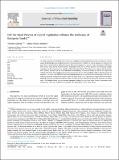Files in this item
Did the Basel process of capital regulation enhance the resiliency of European banks?
Item metadata
| dc.contributor.author | Gehrig, Thomas | |
| dc.contributor.author | Iannino, Maria Chiara | |
| dc.date.accessioned | 2021-07-14T10:30:41Z | |
| dc.date.available | 2021-07-14T10:30:41Z | |
| dc.date.issued | 2021-08 | |
| dc.identifier | 274671765 | |
| dc.identifier | a7ed987e-2c4d-43db-805a-dc1488d3c8ca | |
| dc.identifier | 85108844395 | |
| dc.identifier | 000713699200005 | |
| dc.identifier.citation | Gehrig , T & Iannino , M C 2021 , ' Did the Basel process of capital regulation enhance the resiliency of European banks? ' , Journal of Financial Stability , vol. 55 , 100904 . https://doi.org/10.1016/j.jfs.2021.100904 | en |
| dc.identifier.issn | 1572-3089 | |
| dc.identifier.other | RIS: urn:2CF61D857D88B151F7AD930E81792F7C | |
| dc.identifier.other | ORCID: /0000-0002-3420-7726/work/95772749 | |
| dc.identifier.uri | https://hdl.handle.net/10023/23545 | |
| dc.description.abstract | This paper analyses the evolution of the safety and soundness of the European banking sector during the various stages of the Basel process of capital regulation. We document the evolution of various measures of systemic risk as the Basel process unfolds. Most strikingly we find that the exposure to systemic risk as measured by SRISK has been steeply rising for the highest quintile, moderately rising for the second quintile, and remaining roughly stationary for the remaining three quintiles of listed European banks. This observation suggests that during the Basel process, systemic risk has been contained for the majority of European banks, but not for the largest and riskiest institutions. When analyzing the sources of systemic risk we find compelling evidence that the increase in exposure to systemic risk (SRISK) is tied to the implementation of internal models for determining credit risk, as well as market risk. Based on this evidence, the sub-prime crisis found especially the largest and more systemic banks ill-prepared and lacking resiliency. This condition has been aggravated during the European sovereign crisis. The Banking Union has not restored aggregate resiliency to pre-crisis levels. Finally, low-interest rates considerably affect the contribution to systemic risk, particularly for the riskier banks. | |
| dc.format.extent | 2972351 | |
| dc.language.iso | eng | |
| dc.relation.ispartof | Journal of Financial Stability | en |
| dc.subject | Bank capital | en |
| dc.subject | Systemic risk | en |
| dc.subject | Internal risk-based models | en |
| dc.subject | Contagion | en |
| dc.subject | Resilience | en |
| dc.subject | Regulation | en |
| dc.subject | HG Finance | en |
| dc.subject | 3rd-DAS | en |
| dc.subject.lcc | HG | en |
| dc.title | Did the Basel process of capital regulation enhance the resiliency of European banks? | en |
| dc.type | Journal article | en |
| dc.contributor.institution | University of St Andrews. School of Economics and Finance | en |
| dc.identifier.doi | https://doi.org/10.1016/j.jfs.2021.100904 | |
| dc.description.status | Peer reviewed | en |
This item appears in the following Collection(s)
Items in the St Andrews Research Repository are protected by copyright, with all rights reserved, unless otherwise indicated.

